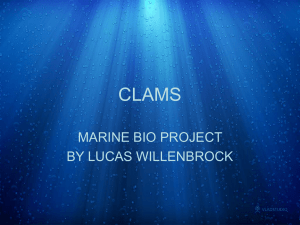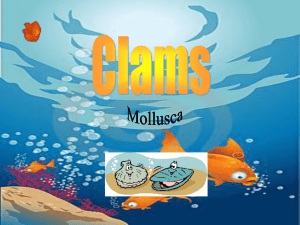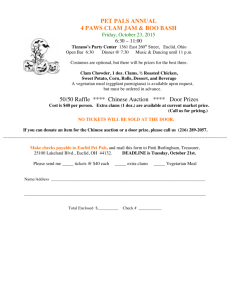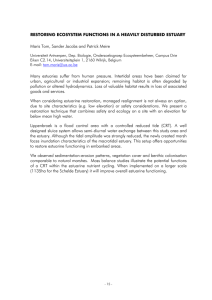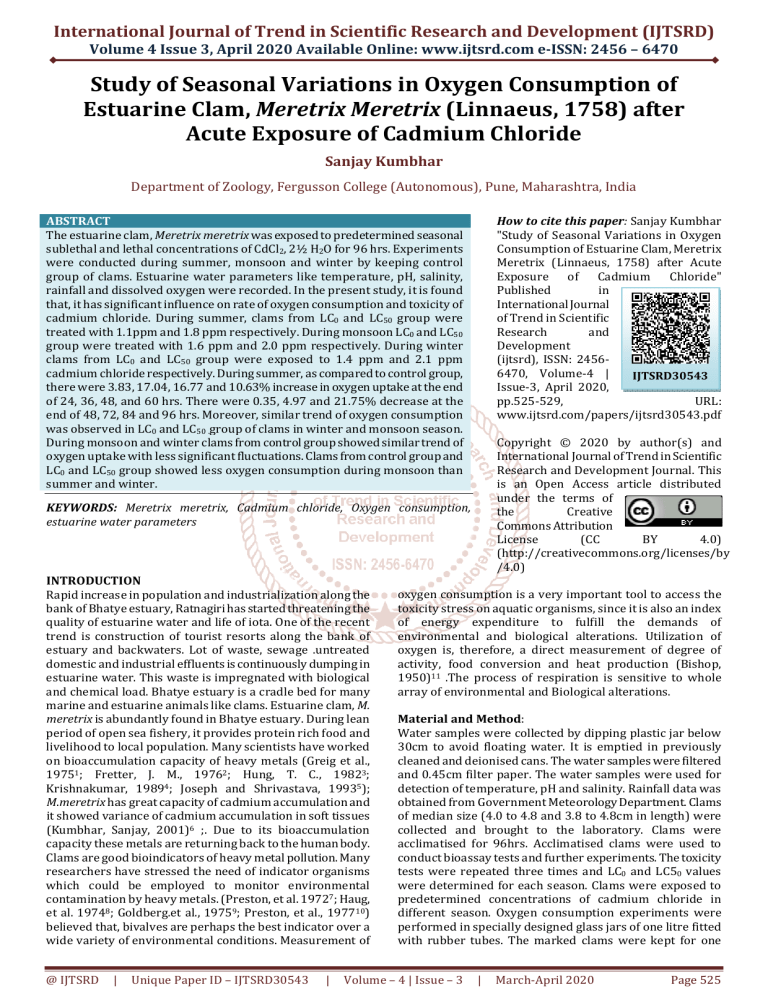
International Journal of Trend in Scientific Research and Development (IJTSRD)
Volume 4 Issue 3, April 2020 Available Online: www.ijtsrd.com e-ISSN: 2456 – 6470
Study of Seasonal Variations in Oxygen Consumption of
Estuarine Clam, Meretrix Meretrix (Linnaeus, 1758) after
Acute Exposure of Cadmium Chloride
Sanjay Kumbhar
Department of Zoology, Fergusson College (Autonomous), Pune, Maharashtra, India
How to cite this paper: Sanjay Kumbhar
"Study of Seasonal Variations in Oxygen
Consumption of Estuarine Clam, Meretrix
Meretrix (Linnaeus, 1758) after Acute
Exposure of Cadmium Chloride"
Published
in
International Journal
of Trend in Scientific
Research
and
Development
(ijtsrd), ISSN: 24566470, Volume-4 |
IJTSRD30543
Issue-3, April 2020,
pp.525-529,
URL:
www.ijtsrd.com/papers/ijtsrd30543.pdf
ABSTRACT
The estuarine clam, Meretrix meretrix was exposed to predetermined seasonal
sublethal and lethal concentrations of CdCl2, 2½ H2O for 96 hrs. Experiments
were conducted during summer, monsoon and winter by keeping control
group of clams. Estuarine water parameters like temperature, pH, salinity,
rainfall and dissolved oxygen were recorded. In the present study, it is found
that, it has significant influence on rate of oxygen consumption and toxicity of
cadmium chloride. During summer, clams from LC0 and LC50 group were
treated with 1.1ppm and 1.8 ppm respectively. During monsoon LC0 and LC50
group were treated with 1.6 ppm and 2.0 ppm respectively. During winter
clams from LC0 and LC50 group were exposed to 1.4 ppm and 2.1 ppm
cadmium chloride respectively. During summer, as compared to control group,
there were 3.83, 17.04, 16.77 and 10.63% increase in oxygen uptake at the end
of 24, 36, 48, and 60 hrs. There were 0.35, 4.97 and 21.75% decrease at the
end of 48, 72, 84 and 96 hrs. Moreover, similar trend of oxygen consumption
was observed in LC0 and LC50 .group of clams in winter and monsoon season.
During monsoon and winter clams from control group showed similar trend of
oxygen uptake with less significant fluctuations. Clams from control group and
LC0 and LC50 group showed less oxygen consumption during monsoon than
summer and winter.
Copyright © 2020 by author(s) and
International Journal of Trend in Scientific
Research and Development Journal. This
is an Open Access article distributed
under the terms of
the
Creative
Commons Attribution
License
(CC
BY
4.0)
(http://creativecommons.org/licenses/by
/4.0)
KEYWORDS: Meretrix meretrix, Cadmium chloride, Oxygen consumption,
estuarine water parameters
INTRODUCTION
Rapid increase in population and industrialization along the
bank of Bhatye estuary, Ratnagiri has started threatening the
quality of estuarine water and life of iota. One of the recent
trend is construction of tourist resorts along the bank of
estuary and backwaters. Lot of waste, sewage .untreated
domestic and industrial effluents is continuously dumping in
estuarine water. This waste is impregnated with biological
and chemical load. Bhatye estuary is a cradle bed for many
marine and estuarine animals like clams. Estuarine clam, M.
meretrix is abundantly found in Bhatye estuary. During lean
period of open sea fishery, it provides protein rich food and
livelihood to local population. Many scientists have worked
on bioaccumulation capacity of heavy metals (Greig et al.,
19751; Fretter, J. M., 19762; Hung, T. C., 19823;
Krishnakumar, 19894; Joseph and Shrivastava, 19935);
M.meretrix has great capacity of cadmium accumulation and
it showed variance of cadmium accumulation in soft tissues
(Kumbhar, Sanjay, 2001)6 ;. Due to its bioaccumulation
capacity these metals are returning back to the human body.
Clams are good bioindicators of heavy metal pollution. Many
researchers have stressed the need of indicator organisms
which could be employed to monitor environmental
contamination by heavy metals. (Preston, et al. 19727; Haug,
et al. 19748; Goldberg.et al., 19759; Preston, et al., 197710)
believed that, bivalves are perhaps the best indicator over a
wide variety of environmental conditions. Measurement of
@ IJTSRD
|
Unique Paper ID – IJTSRD30543
|
oxygen consumption is a very important tool to access the
toxicity stress on aquatic organisms, since it is also an index
of energy expenditure to fulfill the demands of
environmental and biological alterations. Utilization of
oxygen is, therefore, a direct measurement of degree of
activity, food conversion and heat production (Bishop,
1950)11 .The process of respiration is sensitive to whole
array of environmental and Biological alterations.
Material and Method:
Water samples were collected by dipping plastic jar below
30cm to avoid floating water. It is emptied in previously
cleaned and deionised cans. The water samples were filtered
and 0.45cm filter paper. The water samples were used for
detection of temperature, pH and salinity. Rainfall data was
obtained from Government Meteorology Department. Clams
of median size (4.0 to 4.8 and 3.8 to 4.8cm in length) were
collected and brought to the laboratory. Clams were
acclimatised for 96hrs. Acclimatised clams were used to
conduct bioassay tests and further experiments. The toxicity
tests were repeated three times and LC0 and LC50 values
were determined for each season. Clams were exposed to
predetermined concentrations of cadmium chloride in
different season. Oxygen consumption experiments were
performed in specially designed glass jars of one litre fitted
with rubber tubes. The marked clams were kept for one
Volume – 4 | Issue – 3
|
March-April 2020
Page 525
International Journal of Trend in Scientific Research and Development (IJTSRD) @ www.ijtsrd.com eISSN: 2456-6470
hour. Dissolved Oxygen was determined by Winklers method
.The rate of oxygen consumption of LC0 and LC50 groups
along with control after every 12 hrs time interval was
determined. The experiments were repeated for three times
for confirmation of results. Such experiments were
conducted during summer, monsoon and winter of the year
2017.
Results and discussion
Table1. The water parameters of Bhatye Estuary, Ratnagiri (2017–18)
Surface Water
Rainfall Salinity
Season
pH Dissolved Oxygen (ml/l)
Temperature.
(mm)
(mg/l)
Summer (April-May)
Avgas- 26.9
35.2
8.1
3.5
Monsoon (July- August)
26.1
34.39
5.2
7.29
5.0
Winter (Nov- Dec)
25.5
5.2
30.36
8.5
4.3
In the present study, it was found that during summer and winter, temperature was higher as compared to monsoon. Influx of
freshwater through rivers and intrution of sea water through the lower reaches have profound influence on the distribution of
temperature in backwater systems (Pillai, et al., 1975)12. It was observed that, temperature, oxygen saturation, salinity are
interrelated parameters. Temperature was directly proportional to salinity and inversely proportional to dissolved oxygen, it
affects oxygen concentration in water. At Ratnagiri, the rainfall was maximum in the month of July (34.39) but later on it
decreased. There was scanty rainfall (0.006) in winter and no rainfall in summer. Maximum average salinity was recorded in
summer (35.2). It was 30.36mg/l in winter. Minimum average salinity was recorded in monsoon season (5.2). The
bioaccumulation and toxicity of metals increases with increase in temperature. The absorption and release of metals can also
depend on temperature. This was established for mercury, methyl mercury and phenyl acetate in rainbow trout, Salmo
guardeneri. (Mc Leod, 1973)13.
Salinity is key trigger of other environmental factors. It depends on certain factors as local precipitation, water influx, mixing of
fresh water with sea water and evaporation. Hence, salinity is more labile parameter than any other estuarine water parameter.
In the present study, it varied according to season. It was maximum (35.2) in summer and minimum (5.2) in monsoon. Salinity
is key trigger of other environmental characteristics. It depends on certain factors as, local precipitation, water influxes, mixing
of seawater with fresh water and evaporation. In the present investigation seasonal fluctuations were quiet well marked. Low
salinity was observed during monsoon, due to heavy rainfall in the basin of Kajali river, which causes dilution. Similar
observations were also made by other workers (Ramamurti, 195314; Nixon, 200115; Loankar, 197116)
The values of oxygen saturation varied seasonally in the estuarine waters. In general, during monsoon, saturation was better
than those of summer and winter. It can be attributed to turbulence, freshwater influx and temperature. Similar observations
are noted by Imley, A. J., 196817; Keller, A. E., 199118; Lee. H., 199119.
The average pH was 8.1, 7.29 and 8.E’E.5 in summer, monsoon and winter respectively. The average dissolved oxygen was 3.5,
5.0 and 4.3 in summer, monsoon and winter respectively During monsoon estuarine water shoed maximum saturation of
oxygen (5.0). It was minimum (3.5) in summer variations in pH did not show significant seasonal pattern. However, the pH
values were low during monsoon due to heavy influx of freshwater. Similar observations were noted by Chandran and
Ramamurti (1984)20 in velar estuary .The hydronomics of an estuary in general is very complex because of the interdependable
variables like tide, river discharge, and density difference in the water masses in the estuary, salinity and temperature. In the
present investigation it is found that these interrelated estuarine water parameters were highly liable and had profound
influence on oxygen consumption of. M. meretrix.
Table 2: Rate of oxygen consumption (ml/l/hr/gm wet wt) in M.meretrix exposed to different concentrations of
cadmium chloride after acute exposure.
Exposure Time
Group
0 Hrs 12 Hrs 24 Hrs 36 Hrs
48 Hrs
60 Hrs
72 Hrs
84 Hrs
96 Hrs
0.220
0.283
0.287
0.264
o.298
0.283
0.285
0.295
0.262
Control
±0.013 ±0.061 ±0.004 ±0.038
±0.01
±0.012
±0.026
±0.004
±0.012
0.275
0.298
0.309
0.348
0.365
0.284
0.251
0.205
0.208
LC0
±0.013 ±0.005 ±0.063
±0.013
±0.017
±0.032
±0.014
±0.023
±0.007
Summer
(-2.82) (3.83) (17.04)
(16.77)
(10.63)
(-0.35)
(-4.97)
(-21.75)
0.244
0.305
0.295
0.179
0.337
0.205
0.153
0.084
0.225
LC50
±0.057 ±0.068 ±0.025
±0.004
±0.06
±0.02
±0.012
±0.005
±0.051
(-13.78) (6.27) (11.74)
(-39.93)
(20.37)
(39.02)
(-18.13) (-25.89)
0.186
0.24
0.205
0.227
0.237
0.218
0.212
0.231
0.247
Control
±0.021 ±0.015 ±0.016 ±0.071
±0.005
±0.02
±0.008
±0.078
±0.022
0.233
0.241
0.277
0.294
0.321
0.276
0.243
0.281
0.183
LC0
±0.065
±0.01
±0.049
±0.036
±0.004
±0.01
±0.069
±0.064
Monsoon
±0.055
(-2.91) (17.56) (22.02) (24.05)** (47.24) ** (30.18) ** (5.19)
(-11.74)
0.279
0.305
0.117
0.108
0.144
0.068
0.093
0.051
0.182
LC50
±0.025 ±0.009 ±0.088
±0.04
±0.076
±0.01
±0.021
±0.014
±0.007
(-4.12) (0.99) (-58.65) (-62.75)** (-45.24) (-74.81)*** (-64.78) (-71.71)***
@ IJTSRD
|
Unique Paper ID – IJTSRD30543
|
Volume – 4 | Issue – 3
|
March-April 2020
Page 526
International Journal of Trend in Scientific Research and Development (IJTSRD) @ www.ijtsrd.com eISSN: 2456-6470
0.258
0.243
0.229
0.250
0.230
0.263
0.260
0.237
±0.07
±0.017 ±0.024
±0.032
±0.019
±0.013
±0.045
±0.015
0.239
0.283
0.322
0.366
0.385
0.378
0.341
0.317
0.193
LC0
±0.098 ± 0.049 ±0.006
±0.021
±0.055
±0.019
±0.064
±0.095
Winter
±0.018
(-6.37) (16.46) (40.61)** (46.40)** (67.69)* (43.72)** (31.15)
(33.75)
0.261
0.305
0.213
0.141
0.205
0.243
0.210
0.136
0.184
LC50
±0.005 ±0.065 ±0.016
±0.045
±0.018
±0.052
±0.071
±0.009
±0.049
(1.16) (25.51) (-6.98) (-43.60)** (-10.86)
(-7.60)
(-7.31) (-42.61)***
Values in parenthesis are percent change, ± = S.D. of five animals (*=p < 0.05, * *= p < 0.01, *** = P < 0.001).
Control
0.197
±0.073
Fig.1. Rate of oxygen consumption of M. meretrix exposed to cadmium chloride
Summer
Exposure period in hrs
Monsoon
Exposure period in hrs
Oxygen consumption is measure of animals overall energy
demand under particular conditions, at which the
measurements are made. The process of respiration is
sensitive to whole array of environmental as well as
biological variables. Oxygen consumption is useful measure
to assess the sub lethal effects of xenobiotics, as energy
processes serves as an indicators of overall physiological
state (Sigmund, 1979)21 .During summer .In control group,
the rate of oxygen consumption fluctuated between 0.220
and 0.298 ml/l/g/h from 0 to 96 h. In LC0 (1.1 ppm) group,
the rate of oxygen consumption fluctuated between 0.208 to
0.365 ml/g/h from 0 to 96 h. From 0 to 60 h, there was
considerable increase from 0.208 to 0.365 ml/l/g/h. From
72 h to 96 h, the rate of oxygen consumption decreased from
@ IJTSRD
|
Unique Paper ID – IJTSRD30543
|
0.284 to 0.205 ml/l/g/h. As compared to control, there was
3.83, 17.04, 16.77 (p<0.001), and 10.63% increase in oxygen
uptake at the end of 72, 84, and 96 h respectively. In LC50
(1.8 ppm) group, there was considerable increase from
0.225 to 0.305 ml/g/l/h, at the end of 24h. At 36 and 48 h
oxygen consumption was decreased up to 0.295 and 0.179
ml/l/g/h respectively. From 60 to 96 h, this rate was
considerably decreased from 0.337 to 0.084 ml/l/g/h. In
LC50 group, compared to control, there is a significant
(p<0.001) decrease of 39.93, 39.02, 48.13 and 25.89% at the
end of 48, 72, 84, 96 h, while 6.27, 11.74, 20.37% (p<0.001)
increase in oxygen uptake at the end of 24, 36, 60 h
respectively
Volume – 4 | Issue – 3
|
March-April 2020
Page 527
International Journal of Trend in Scientific Research and Development (IJTSRD) @ www.ijtsrd.com eISSN: 2456-6470
During monsoon, in control group, the rate of oxygen
consumption fluctuated between 0.186 to 0.247 ml/l/g/h. In
LC0 (1.3 ppm) group, rate of oxygen consumption fluctuated
between 0.183 to 0.321 ml/l/g/h, from 0 to 60 h. From 72 to
84 h, it was decreased from 0.276 to 0.243 ml/l/g/h, again,
there was considerable increase at 96 h (0.281 ml/l/g/h). As
compared to control group, there was 17.56, 22.02, 24.05
(p<0.01), 47.24 (p<0.01), 30.18 (p<0.01) and 5.19% increase
in oxygen uptake at the end of 24, 36, 48, 60, 72 and 84h
respectively. There was 2.91 and 11.74% no significant
decrease in oxygen uptake at the end of 12 and 96 h
respectively. In LC50 (2.0 ppm) group, rate of oxygen
consumption fluctuated between 0.051 and 0.305 from 0 to
96 h. From 0 to 24 h, rate of oxygen consumption increased
from 0.182 to 0.305 ml/l/g/h. From 24 h onwards, it was
decreased up to 0.108 ml/l/g/h at the end of 48 h. From 24 h
onwards, it was decreased up to 0.108 ml/l/g/h at the end of
48 h. From 60 h, it was sharply decreased from 0.144 to
0.051 at the end of 96 h. In LC50 group, compared to control,
there was 4.12, 58.65, 63.75 (P<0.01), 45.24, 74.81
(p<0.001), 64.78 and 71.71% (p<0.001) decrease at the end
of 12, 36, 48, 60, 72, 84 and 96 h respectively. There was no
significant increase of 0.99% at the end of 24 h.
During winter, control group of clam showed fluctuations in
rate of oxygen consumption between 0.197 to 0.073
ml/l/g/h. In LC0 (1.5 ppm) group, rate of oxygen
consumption fluctuated between 0.193 to 0.385 ml/l/g/h
from 0 to 96 h. There was considerable increase from 0.193
to 0.385 ml/l/g/h at the end of 60h. From 72 to 96 h, there
was considerable decrease from 0.378 to 0.317 ml/l/g/h. In
LC50 group, compared to control, clams consumed 16.46,
40.61 (p<0.01), 46.40 (p<0.01), 67.69 (P<0.05), 43.72
(p<0.01), 31.15 and 33.75% more oxygen at the end of 24,
36, 48, 60, 72, 84 and 96 h respectively. There was 6.37% no
significant decrease at the end of 12 h. In LC50 (2.1ppm)
group, rate of oxygen consumption fluctuated between 0.136
to 0.305 ml/l/g/h. There was considerable increase from
0.164 to 0.305 ml/l/g/h from 0 to 24 h. At 36 h, clams
consumed 0.213, 0.141 and 0.205 ml/l/g/h at the end of 36,
48, and 60 h respectively. From 72 h onward, rate of oxygen
consumption decreased from 0.243 to 0.136 ml/l/g/h at the
end of 96 h. As compared to control, there was 6.98, 43.60
(p<0.01), 10.86, 7.60, 7.31 and 42.61% (p<0.001) decrease
.In the present study it is found that clams from control
group consumed more oxygen in summer and less in
monsoon .The fluctuations in the estuarine environment
where clams are found are therefore bound to influence the
oxygen consumption correlated with estuarine environment.
In the present study, it was found that clams from control
group showed fluctuations in oxygen consumption, but
fluctuations were more during monsoon. The salinity and
temperature data (Table 1) shows that, during monsoon,
when river enters the estuary, salinity decreases due to
freshwater influx. It has been observed that, the rate of
water filtration and metabolic activity decreases during
monsoon because for the majority of period, values of clams
remained closed in low salinity .In winter, oxygen
consumption was less than in summer. It may be due to
presence of optimum range of water parameters and
physiological status of clams at that time. During summer,
clams exhibited higher degree of oxygen consumption. It
may be due to depleted oxygen content in water and
cadmium induced stress. (Isono. Raisuke et al., 1998)22
report that, in Japanese little neck clam ruditapes
@ IJTSRD
|
Unique Paper ID – IJTSRD30543
|
philippinarium, the oxygen rate decreased markedly above
400 C. Clams suffer from thermal stress over 250 C and has
significant mortality at around 340 C within a few days and
no heat resistance over 400 C. (Hare et al., 1998)23 observed
enhanced oxygen consumption rate in flat oyster Ostrea
edulis during summer (Young and Shim- Ieong- Her, 1998)24
observed increased rate of oxygen consumption during
summer in the Antartic clam, Laternula ellipitica .Similar
observations were made by (Ranade, 1970)25 in case of
clams from Ratnagiri waters.
As compared to summer and winter, in monsoon, control
group of clams showed decreased oxygen uptake. Clams
closed their shell valves for most of the time to avoid
unfavourable estuarine water parameters. Similar
observations were noted by (Ranade, 1973)26 .As compared
to control group of clams, LC50 group showed decreased
oxygen uptake in 3 different seasons. The observed decrease
is attributed to variance in the volume of water ventilated
through the gills, caused by the intermittent closure and
opening of shell valves. Here the main factor which caused
oxygen decreased uptake was due to coagulation of mucus
on gills due to cadmium exposure. Coagulation of mucus
causes reduction in effective transport of oxygen to internal
tissues. Coagulation film anoxia adversely affects the
absorption of oxygen from the ambient medium. (Brown and
Nevel, 1972)27 have suggested that, reduced oxygen uptake
maybe due to reduced energy requirement caused by
suppression of ciliary activity in the present study;
considerable mucus secretion was found in the clams from
LC0 and LC50 group. These fluctuations in oxygen uptake in
M.meretrix are due to cadmium chloride stress and estuarine
water parameters.
Conclusion
The present study gives a detailed account of impact of CdCl2
stress on oxygen consumption of clams from control, LC0 and
LC50 group. It reveals interaction between seasonal estuarine
water parameters n consumption. Experimental results
showed that, clams from control group consume more
oxygen in summer and less in monsoon. It is attributed to
seasonal estuarine water parameters like temperature, pH,
oxygen, saturation and salinity. Clams from LC0 and LC50
group showed marked initial increase and later significant
decrease at the end of 96 h. This trend was similar in all
three different seasons. It is clear that these fluctuations
were due to CdCl2 stress and not due to seasonal estuarine
water parameters.
Acknowledgement:
The author gratefully acknowledges Dr. D.V Mule, Ret. Prof.,
Dept. of Zoology Shivaji University Kolhapur for his immense
and valueable guidance.
References
[1] Greig, R. A.; B. A. Nelson and D. A. Nelson (1975): Trace
metal content in American oysters. Mar. Pollut. Bull.,
6:72- 79.
[2] Fretter, J. M., (1976): The dynamics of metals in
American oyster, Crossostrea virginica .Environmental
effects Chesapeake Sci., 17:187-191.
[3] Hung, T. C (1982): Study on heavy metals in rivers and
estuaries of western Taiwan. Sustainable clean water.
Proceesings of the regional workshop management in
Volume – 4 | Issue – 3
|
March-April 2020
Page 528
International Journal of Trend in Scientific Research and Development (IJTSRD) @ www.ijtsrd.com eISSN: 2456-6470
the developing countries of Asia and the Pacific, uni. Of
Malaya, Kuala Lumpur, Malaysia. Lim, R. P.; Viner, A. B.;
Lim L. H. S.; Furtado, J. I. eds, 28 181-192.
[15] Nixon, S. W and B. A. Buckley (2001): ‘A strikingly rich
zone’ nutrient enrichment and secondary production in
coastal marine ecosystems, J. Estuaries (25):782-796.
[4] Krishnakumar, P. K, G. S Bhatt, N. G. Vaidya and V. K
Pillai (1998): Heavy metal distribution in the biotic and
abiotic matrices along Karnataka coast, west coast of
India. Indian journal of marine sciences ., 27 (2) 201205
[16] Loankar, S.D (1972): Seasonal variations in the
hydrological conditions in the coastal waters of
Ratnagiri. Mahasagar. Vol. 4, 101 -106
[5] Joseph, K. O. and J. P., Shrivastav (1993): Heavy metal
load in edible oyster, crossostrea madrasencis from the
Ennore estuary, Madras. J. Environ. Biol., 14 (2) 121127
[6] Kumbhar, Sanjay (2001): Cadmium induced toxicity to
the estuarine clams from Ratnagiri, coast of
Maharashtra, pp 45-56, 59-65, 145-155.
[7] Preston, A. D., D. S. F. Jeffereince, B. R, Harvey and A. K,
Steele .(1972): British islets coastal water: The
concentration of selected matter and biological
indicators- a pilot survey Environ. Pollut., 3:69-82.
[8] Haug, P. C .(1982): Study on heavy metals in rivers and
estuaries of western Taiwan. Proceedings of the
regional workshop on Limnology pp 82-97
[9] Goldberg, E. D. (1975): The mussel watch – a first step
in global marine monitoring. Mar. poll. Bull, 6:111-115
[10] Preston, E. (1977): The importance of ingestion in
chromium-51 accumulation by Crassostrea virgilica. J.
Exp. Mar. Biol. Ecol: 6:47-54
[11] Bishop, S. H and J. M Burcham (1983): Amino acid
metabolism in the molluses (Ed) Wilbor, K.M Acad.
Press. New York. Vol. 1 244-328
[12] Pillai, V. K. and K. K. Valsala (1995): Seasonal variation
of some metals in bivalve mollusk Sunetta scripta from
the Cochin coastal waters .Indian journal of Marine
Sciences. Vol. 24: 113-115
[13] Mcleod, R.M and B. Pesseh (1973): Temperature effects
on mercury accumulation, toxicity and metabolic rate
in rain bow trout. J. Fish Res. Board Canada. 30, 485512
[14] Ramamurth, S. (1953): Hydrological studies in Madras
coastal waters. J. Madras. Uni. 13 (B):148-163.
@ IJTSRD
|
Unique Paper ID – IJTSRD30543
|
[17] Imlay, M. J. (1968): Environmental factors in activity
rhythms of the freshwater clam Elliptio complanatus
catawbensis (Lea). Am. Midl. Nat. 80, 508-28
[18] Keller, A. E and Zam, S. G.(1991): The acute toxicity of
selected metals to the freshwater mussel, Anodonta
imbecilis. Environ. Toxicol. Chem ., 10, 539-46
[19] Lee, H. (1991): A clam’s eye view of the bioavailability
of sediment-associated pollutants. In Baker, R. A. ed.
Organic substances and sediments in water, pp., 73-93.
Chelsea: Lewis Publishers.
[20] Chandran, R. and K. Ramamurthi, (1984):(a)
Hydrobiological studies in the gradient zone of the
vellar estuary. J. Mahasagar, 17:69-77.
[21] Sigmund, C. (1979): Oxygen consumption in Daphnia
pulex exposed to cadmium. Environ. Toxicol., 21:822825.
[22] Isono Ryosuke; S. K. Kita and Kishida, Chiho. (1998):
Upper temperature effect on rates of growth and
oxygen consumption of the Japanese littleneck clam,
Rudetapes philipinanem. Nipp. On suisan Gakaiski 64
(3), 373-376
[23] Harve, G. N., Underdal B and Christinsen,
(1973):Influence of temperature on clearance and
oxygen consumption rate of, Ostrea eudilis Aquaculture,
169 (3-4) 211-224
[24] Ranade, M. R. (1973): Effect of temperature and
salinity on the oxygen consumption in clams. Jornal of
Bombay Natural Hist. Society, 70 (1) .128-146
[25] Brown, B. and R. Nevel (1972): The effect of copper and
zink on the metabolism of mussel, Mytilis eudilis. Mar.
Biol., 16: 108-115.
[26] Ranade M. R and C.V Kulkarni (1969): Observation on
the behaviour of clams in water of low salinity. J.
Bombay Nat. Hist. Soc., 69 (3) 616-634
Volume – 4 | Issue – 3
|
March-April 2020
Page 529

